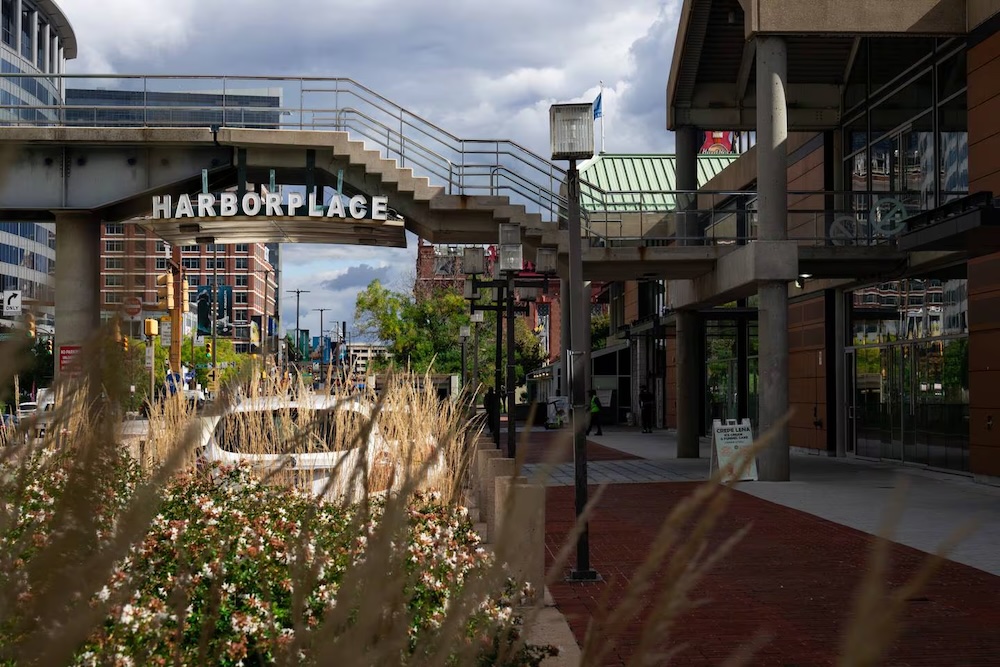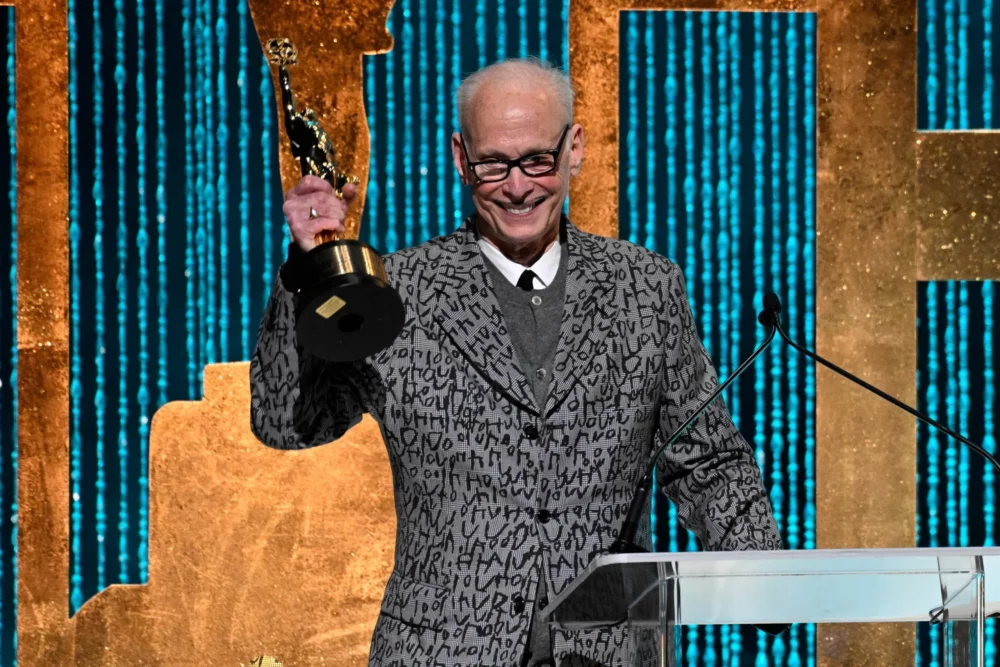How one Baltimore County man turned his backyard into an Egyptian wonder
by Rona Kobell
Published March 11 in The Baltimore Banner
When an 80-year-old man says he’s taken up wood carving in retirement, you might picture a backyard with a small shed, a bench, maybe a half-finished walking stick or duck decoy.
Junius Wilson’s Woodlawn backyard has none of those things.
Instead, there is a giant pyramid, a three-breasted goddess with the face of a golden calf, a carved face that is half-lion and half-pharaoh, and a replica of the lascivious serpent from the Garden of Eden. There are also Eyes of Horus, faux Sumerian carvings and plenty of ankhs, the Egyptian looped cross.
Imagine that an Alberto Giacometti sculpture and a Howard Finster painting had a baby and moved to a Levittown suburb, and you get the idea. A house that looks ordinary from the street is extraordinary in the hands of Wilson, who expressed himself as a musician and a clown before he took up carving 10 years ago as an antidote to crippling depression.
Since then, Wilson has been creating a world. He’s running out of room — his wife Ilona, a retired social services administrator, would like her house and yard back. And he is running out of time. Still healing from a 30-foot fall off some scaffolding three decades ago, Wilson just learned he has colon cancer. He’s undergoing treatment, and the prognosis looks good. But his advanced age, coupled with his health challenges, are front of mind for Wilson these days as he tries to finish what he started. He would also like a museum to take his work and display it. But he and his friends have asked around, and it turns out there are not a lot of places on the market for a backyard Egypt, complete with light-up volcanoes, two-faced babies, and a figure with a brain you can peer inside.
“He’s not a wood carver as much as he is a sculptor. He will say, ‘I don’t know what it’s going to be. I have to wait for the wood to talk to me,’” said Peter Turner, a friend and fellow artist who met Wilson when they both joined the Carroll Carvers club at the North Carroll Senior Center.
Once, Turner recalled, when the two exhibited Wilson’s work at a senior center, Wilson brought in dancing girls dressed as Cleopatra whom he knew from his connections as a club musician. “We used to joke with him, ‘Junius, you have to make something small.’ And, the next thing we know, he’s buying all these chainsaws and attacking pieces of wood.”
Most carvers place a picture over a piece of wood and trace it. For Wilson, the picture springs from his mind. He sees the figure and begins to carve. It shifts with his imagination as he works, and the finished piece looks nothing like he initially envisioned.
Another carver, Robert Dentry, recalled making a walking stick with a lion’s mane on top. Wilson liked the piece, and he asked Dentry to help him with a mane he was trying to carve. Dentry was expecting a walking stick. Instead, he found the base of Wilson’s 12-foot pyramid masterpiece, which at the time was only a pole on top of a stump.
Dentry thought his friend was crazy, but he began carving anyway.
“As I was carving the lion, Junius said it kind of looked like a pharaoh, and I said, ‘What if we did half and half?’ So he actually molded my mind to think like his, at least a little bit,” Dentry said. “The picture evolves as he’s doing it — that is what is really interesting about it. It comes from his mind, and from his heart.”
Now his backyard is full of expressions of his mind and heart.
A mulberry-colored ram has one face like a Picasso bull, another like a Matisse dairy cow. There are Black figures in chains, representing both the slaves in Egypt and the Africans brought to the ports in Annapolis. Jackals guard the premises, and a river — a landscaped brick path masquerading as the Nile — runs through the whole scene.
Throw in a basement collection filled with meticulously carved bowls that double as faces; a two-faced, three-dimensional baby; a bleeding Jesus; a sinewy figure that shows Caitlyn Jenner today on one side and her as an Olympic-winning decathlete on the other.
Many creators of so-called “outsider art” tell of an epiphany that took them from a mundane or difficult life to one brimming with creativity. From Baltimore’s American Visionary Art Museum to Finster’s Paradise Garden in Atlanta, stories abound about visions, signs from God, life-threatening accidents and traumas that brought on the gift of art.
Wilson is no exception. He was working as an electrician in the late 1980s when one of his colleagues got stuck on 277 volts of electricity. Wilson went to save him, and he fell 30 feet to the ground. He crushed two vertebrae and suffered several concussions. He was on crutches for five years. The experience sent him into a deep depression. For weeks on end, he and his wife say, he could not get out of bed. They said the depression lasted 30 years. He tried therapy, medication and exercises, but nothing helped.
Wilson says he bargained with God to take him; his doctor told him the best way out was to get a hobby. So he went to Home Depot to buy shelves, thinking he would start with arranging his books and maybe some building. The bookcase he made collapsed. But, as he picked up the pieces, he said, he saw a figure in one of the wood pieces.
“I went into the kitchen and got a knife, and I just started carving around this figure. I knew nothing about carving. I can’t even draw a stickman,” he said. “And I’ve been carving ever since.”
That piece won second prize in the first carving competition he entered; the judges told him that, had they seen the entire figure instead of just the top of it, he would have won first.
A depressed Wilson is hard to imagine now. He’s ebullient as he shows his work. It’s easy to picture his success as a clown, whom he called Freedom Man, and as a saxophonist and spoken-word poet in the East Baltimore clubs. Turner recalled that when and Wilson visited Walter Reed National Military Medical Center to give away walking sticks they’d carved for disabled veterans, Wilson commandeered an electric scooter and cruised around the halls, in addition to snagging a photo with a visiting beauty contestant on a goodwill visit.
On a recent trip to Egypt, his first, a guide explained why a goddess-queen at a temple was missing her head. Wilson told the guide he could figure out how to carve it back on. Though the guide didn’t take him up on it, Wilson memorialized the temple scene on one of his backyard sculptures and placed the queen’s head back where it belonged.
“He’s just a piece of sugar,” said Lonnie Margolis, who got to know Wilson when he spent months carving a Ukrainian peace sculpture out of a tree that had partially fallen in her yard. “When he is carving, he is in his own world, having a wonderful time. He is doing something so creative, and you can see it is a love.”
Even with such unassailable energy, he acknowledges that he is slowing down. He wants more time with his sons and their children. His wife wants more space. And his collection is hidden from the people he wants most to see it. Aside from a couple of shows at senior centers and a few nosy neighbors peering over the fence, few have seen his gift, which he always wanted to share with the world.
“My pieces tell stories, from beginning to end. You will not find that any other place,” he said. “My maker, you know, he gave me all this information. He said, ‘You got it. I gave it to you. And now you have to pass it on.’”
This story was republished with permission from The Baltimore Banner. Visit www.thebaltimorebanner.com for more.

















